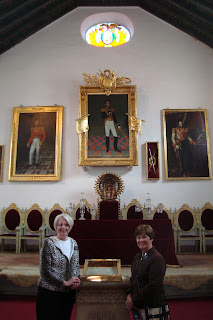 |
| This bull was right on the trail as we hiked in. |
 |
| On the hike with a "river" and waterfall in the background. |
 |
| All the missionaries at the picnic area. We each brought our own lunch and then something to share. We also spent some time playing cards before we went to the "summer home". |
 |
| These are typical steps by the waterfall. All the steps in Bolivia are uneven. They just use the boards that are available and whatever size they are is the size the steps will be. |
 |
| This is the fountain in the courtyard. |
 |
| This lawn and statue are right in front of the house. |
 |
| This pond is by the side of the house and has goldfish in it. |
 |
| Elder Dibb visited with this little boy for a while. He lived on the estate with his family, who worked on the grounds. It was a beautiful place. |










































